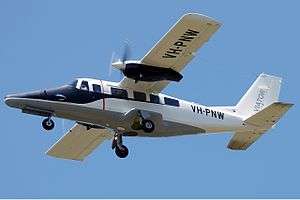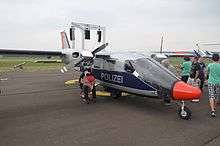Partenavia P.68
| P.68 | |
|---|---|
 | |
| Partenavia AP.68TP-600 Viator in 2011 | |
| Role | Light transport |
| Manufacturer | Partenavia Vulcanair |
| Designer | Luigi Pascale |
| First flight | 1970 |
| Number built | 431+ |
| Unit cost | |

The Partenavia P.68, now Vulcanair P68, is an Italian six-seat, twin-engined, high-wing monoplane built by Partenavia and later Vulcanair. Designed by Luigi Pascale and originally put into production in 1972, it was intended for private or business use but has also seen use as both a training and a transport aircraft. It was originally named the Victor, although this name was not used for the production aircraft. The P.68 Observer, which was an Italian/German development, has a transparent nose for use in police work and observation duties.
History
First flown on 25 May 1970, the prototype P.68 was built at Arzano, Italy. It was powered by two 200 hp (149 kW) Lycoming IO-360 piston engines. Production of the P.68 began in 1972 with 14 pre-production aircraft at new facilities in Casoria, Italy. These were followed in 1974 by the P.68B with the fuselage lengthened by 6in (15.2 cm) to create more space in the cockpit. It was superseded in 1979 by the P.68C which had a lengthened nose to accommodate a weather radar. A turbocharged version (the P.68C-TC) was available in 1980. The type license was obtained by Vulcanair, which is still producing the P.68C.
Spartacus
With the help of Aeritalia, development began of a nine-seat turboprop version. The first aircraft, an AP.68TP, first flew in 1978 using Allison 250 turboprops. Although the prototype had a retractable undercarriage, the production aircraft, named the Spartacus, had a fixed undercarriage. Later, a retractable undercarriage version was built as the Viator.
Observer
The German company Sportavia-Putzer modified the P.68 by replacing the nose section with a transparent structure, marketing it as an observation aircraft for law enforcement. Initially, Observers were simply conversions of existing aircraft, but later, they were entirely new aircraft built by Partenavia.
Variants
- P.68 – Initial production version, 14 built.
- P.68B – P.68 with fuselage lengthened by 6-inches and six-seat interior, 190 built.
- P.68 Observer – Modified P.68B with fully glazed nose, over 21 built or modified.
- P.68C – P.68B with longer nose and integral wing fuel tanks, over 114 built.
- P.68C-TC – P.68C fitted with 200 hp Lycoming TI0-360-C1A6D turbocharged engines.
- P.68R – P.68B with retractable undercarriage, one built.
- P.68T – P.68R with lengthened fuselage, larger tail and Allison 250-B17B turboporops, four built.
- AP.68TP – First turboprop powered prototype. First flew on 11 September 1978. Original designation P.68 Turbo.
- AP.68TP-100 – Second turboprop powered prototype.
- AP.68TP-300 Spartacus – P.68T with fixed undercarriage, over 13 built.
- AP.68TP-600 Viator – Spartacus with retractable undercarriage, lengthened nose and stretched fuselage, over 6 built.
- AP.68TP-600 A-Viator as above, with airframe and avionics upgrades, demonstrator flying 2009.
- Spartacus RG – Fitted with a retractable undercarriage.
- Spartacus -10 – stretched version of the Spartacus RG.
Operators
Military and government operators
- Bophutatswana Air Force — Operated two P.68C Observers.[2] Former operator.
- Chilean Navy — 7 P.68 Observer 2s in service since September 2016, order completed in March 2017[3][4]
- National Police Air Service (on order)
Civil operators
- Westpac Life Saver Rescue Helicopter Service (in use prior to late 2009)
- Air Club "SKOPJE"
Incidents and accidents
On July 10, 1978, a P68B registered VH-PNW crashed shortly after take-off from Essendon Airport. Six people on the ground were killed, and one person injured. Three people on the aircraft were seriously injured.[5]
On September 11, 1983, a sales representative was flying a P.68C at an airshow in Plainview, Texas, performing high-speed, high-G maneuvers in excess of the aircraft’s design parameters. During one such maneuver, the wings separated from the rest of the aircraft just outboard of the engine nacelles. The fuselage also twisted longitudinally just before the empennage. The pilot was killed on impact with terrain.[6][7]
On March 2, 2013, a P.68 Observer registered OY-CAG from BioFlight crashed during landing in Roskilde Airport. The two persons on board were killed.[8][9]
Specifications (P.68C)
Data from Jane's All The World's Aircraft 1982–83[10]
General characteristics
- Crew: 1
- Capacity: 6 passengers
- Length: 9.55 m (31 ft 4 in)
- Wingspan: 12.00 m (39 ft 4½ in)
- Height: 3.40 m (11 ft 1¾ in)
- Wing area: 18.60 m2 (200.2 ft2)
- Empty weight: 1,230 kg (2,711 lb)
- Max. takeoff weight: 1,990 kg (4,387 lb)
- Powerplant: 2 × Lycoming IO-360-A1B6 fuel injected, air-cooled flat-four, 149 kw (200 hp) each
Performance
- Maximum speed: 322 km/h (174 knots, 200 mph) at sea level
- Cruise speed: 298 km/h (161 knots, 185 mph) at 3,350 m (11,000 ft) (65% power)
- Stall speed: 106 km/h (57.5 knots, 66 mph) flaps down
- Range: 2,112 km (1,140 nmi, 1,312 mi)
- Service ceiling: 5,850 m (19,200 ft)
- Rate of climb: 7.6 m/s (1,500 ft/min)
See also
References
| Wikimedia Commons has media related to Partenavia P.68. |
- ↑ Fred George (May 2017). "2017 Business Airplanes Purchase Planning Handbook" (PDF). Business & Commercial Aviation. Penton. p. 86-90.
- ↑ Hatch Air Pictorial July 1985, p. 249.
- ↑ Jennings, Gareth (2 September 2016). "Chilean Navy inducts new observation aircraft". IHS Jane's. Retrieved 2 September 2016.
- ↑ Rentería, Antonio Segovia (13 March 2017). "Chilean Navy Aviation receives remainder of its P68 fleet". IHS Jane's 360. Archived from the original on 13 March 2017. Retrieved 13 March 2017.
- ↑ "Partenavia P68B Aircraft VH-PNW near Essendon Airport, Victoria, on 10 July 1978" (PDF). Australian Transport Safety Bureau. Air Safety Investigation Branch. Retrieved 15 November 2015.
- ↑ "Looking Back: Oh my God! 04-27-2008".
- ↑ "News report of the incident YouTube".
- ↑ http://nyhederne.tv2.dk/article.php/id-65448686:dødsulykke-piloterne-skulle-tælle-fugle.html
- ↑ "Archived copy". Archived from the original on 20 August 2013. Retrieved 7 March 2013.
- ↑ Taylor 1982, p.144.
- The Illustrated Encyclopedia of Aircraft (Part Work 1982–1985). Orbis Publishing.
- Hatch, Paul F. (July 1985). "Air Forces of the World: Bophuthatswana Air Force". Air Pictorial. Vol. 47 no. 7. p. 249.
- Simpson, R.W. (1991). Airlife's General Aviation. Shrewsbury, England: Airlife Publishing. ISBN 978-1-85310-194-6.
- Taylor, John W. R. (1982). Jane's All The World's Aircraft 1982–83. London: Jane's Yearbooks. ISBN 978-0-7106-0748-5.